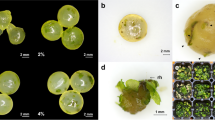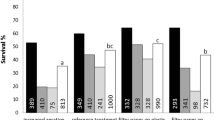Abstract
The overall objective of this study is to present an assessment of embryonic sporophyte development directly “seeded” on growing substrates using the proprietary binder AtSea and three formulations of calcium alginate. We conducted two independent experiments under controlled conditions in a laboratory setup. First, we compared the effect of salinity (0 ppt, 29 ppt, and 35 ppt) on the performance of the calcium alginate formulations. Second, we assessed the effect of direct seeding with binders on the development of sporophytes of four different size classes (i.e., 83.7, 183.1, 345.2, and 522.0 μm in length). Our results show that salinity affects the performance of calcium alginate with 0 ppt media allowing the formation of a thicker hydrogel than that formulated with 29 and 35 ppt. Results also show that AtSea retained more sporophytes than any formulations of calcium alginate. Although effective when cultures were maintained in complete stillness (i.e., no water motion), we detected 70–80% detachment when aeration was added. We also observed what appeared to be delayed sporophyte development compared with sporophytes growing as free floaters.





Similar content being viewed by others
Data availability
Data obtained in the experiments herein can be available upon request.
Change history
04 December 2020
A Correction to this paper has been published: https://doi.org/10.1007/s10811-020-02345-4
References
Aitken D, Bulboa C, Godoy-Faundez A, Turrion-Gomez JL, Antizar-Ladisla B (2014) Life cycle assessment of macroalgae cultivation and processing for biofuel production. J Clean Prod 75:45–56
Bak UG, Mols-Mortensen A, Gregersen O (2018) Production method and cost of commercial-scale offshore cultivation of kelp in the Faroe Islands using multiple partial harvesting. Algal Res 33:36–47
Barry L (2008) Seaweed, potential as a marine vegetable and other opportunities. Australian Government, Rural Industries Research and Development Corporation, Canberra. RIRDC Publication No 08/009, RIRDC Project No CON-9A. 46 pp
Buschmann, AH, Camus, C, Infante, J, Neori, A, Israel, A, & Hernández-González, MC Pereda, SV (2017) Seaweed production: overview of the global state of exploitation, farming and emerging research activity. Eur J Phycol 52:391–406
Cottier-Cook EJ, Nagabhatla N, Badis Y, Campbell M, Chopin T, Dai W, Fang J, He P, Hewitt C, Kim GH, Huo Y, Jiang Z, Kema G, Li X Liu F, Liu H, Liu Y, Lu Q, Luo Q, Mao Y, Msuya FE, Rebours C, Shen H, Stentiford GD, Yarish C, Wu H, Yang X, Zhang J, Zhou Y, Gachon, CMM (2016) Safeguarding the future of the global seaweed aquaculture industry. United Nations University (INWEH) and Scottish Association for Marine Science Policy Brief. 12pp
FAO (2018) The state of world fisheries and aquaculture. Available from: http://www.fao.org/fishery/en. Accessed 23 May 2020
FAO (2020) The state of world fisheries and aquaculture. Available from: http://www.fao.org/fishery/en. Accessed 8 Sept 2020
Forbord S, Steinhovden KB, Solvang T, Handå A, Skjermo J (2020) Effect of seeding methods and hatchery periods on sea cultivation of Saccharina latissima (Phaeophyceae): a Norwegian case study. J Appl Phycol 32:2201–2212
Gegg P, Wells V (2019) The development of seaweed-derived fuels in the UK: an analysis of stakeholder issues and public perceptions. Energy Policy 133:110924
Kerrison PD, Stanley MS, Hughes AD (2018) Textile substrate seeding of Saccharina latissima sporophytes using a binder: an effective method for the aquaculture of kelp. Algal Res 33:352–357
Kim JK, Kraemer GP, Yarish C (2015) Use of sugar kelp aquaculture in Long Island Sound and the Bronx River Estuary for nutrient extraction. Mar Ecol Prog Ser 531:155–166
Kim JK, Stekoll M, Yarish C (2019) Opportunities, challenges and future directions of open water seaweed aquaculture in the United States. Phycologia 58:446–461
Lee KY, Mooney DJ (2012) Alginate: properties and biomedical applications. Prog Polym Sci 37:106–126
Li X, Li X, Zhang Z, Qu S, Liang G, Sun J, Zhao N, Cui C, Cao Z, Li Y, Pan J, Yu S, Wang Q, Luo S, Song S, Guo L, Yang G (2016) Improving seedless kelp (Saccharina japonica) during its domestication by hybridizing gametophytes and seedling-raising from sporophytes. Sci Rep 6:21255
Mariner (2017) Seaweed hatchery and selective breeding technologies. Available at https://arpa-e.energy.gov/?q=slick-sheet-project/seaweed-hatchery-and-selective-breeding-technologies. Accessed 13 May 2020
Percival E, McDowell RH (1967) Chemistry and enzymology of marine algal polysaccharides. Academic Press, London, p 219
Pereira R, Yarish C (2008) Mass production of marine macroalgae. Encycl Ecol:2236–2247
Peteiro C (2017) Alginate production from marine macroalgar, with emphasis on kelp farming. In: Rehm BHA, Moradali MF (eds) Alginates and their biomedical applications. Springer, Cham, pp 27–66
Ropp RC (2013) Group 17 (H, F, Cl, Br, I) alkaline earth compounds. In: Ropp RC (ed) Encyclopedia of the alkaline earth compounds. Elsevier, Amsterdam, pp 25–104
Smale DA, Burrows MT, Moore P, O’Connor N, Hawkins SJ (2013) Threats and knowledge gaps for ecosystem services provided by kelp forests: a northeast Atlantic perspective. Ecol Evol 3:4016–4038
Yarish C, Kim JK, Lindell S, Kite-Powell H (2017) Developing an environmentally and economically sustainable sugar kelp aquaculture industry in southern New England: from seed to market. Stamford, CT
Redmond S, Green L, Yarish C, Kim J, Neefus C (2014) New England seaweed culture handbook-nursery systems. Connecticut Sea Grant, 93 pp. Available at http://www.digitalcommons.uconn.edu/seagrant_weedcult/1/ or http://www.seagrant.uconn.edu/publications/ aquaculture/handbook.pdf. Accessed 2 May 2020
R Core Team, 2016. R: A Language and Environment for Statistical Computing, Vienna, Austria. Available at: https://www.R-project.org/ Accesed 10 June 2020
Acknowledgments
We thank S. Lindell for providing the AtSea binder. We also thank D. Bailey and E. van Sitteren for their insight.
Funding
This study was supported by the Macroalgae Research Inspiring Novel Energy Resources (MARINER, DE-FOA-0001726) to CY as a sub-award to Contract DE-AR0000911.
Author information
Authors and Affiliations
Corresponding author
Ethics declarations
Conflict of interest
The authors declare that they have no conflict of interest.
Additional information
Publisher’s note
Springer Nature remains neutral with regard to jurisdictional claims in published maps and institutional affiliations.
Rights and permissions
About this article
Cite this article
Umanzor, S., Li, Y. & Yarish, C. Effect of direct “seeding” binders and embryonic sporophyte sizes on the development of the sugar kelp, Saccharina latissima. J Appl Phycol 32, 4137–4143 (2020). https://doi.org/10.1007/s10811-020-02277-z
Received:
Revised:
Accepted:
Published:
Issue Date:
DOI: https://doi.org/10.1007/s10811-020-02277-z




